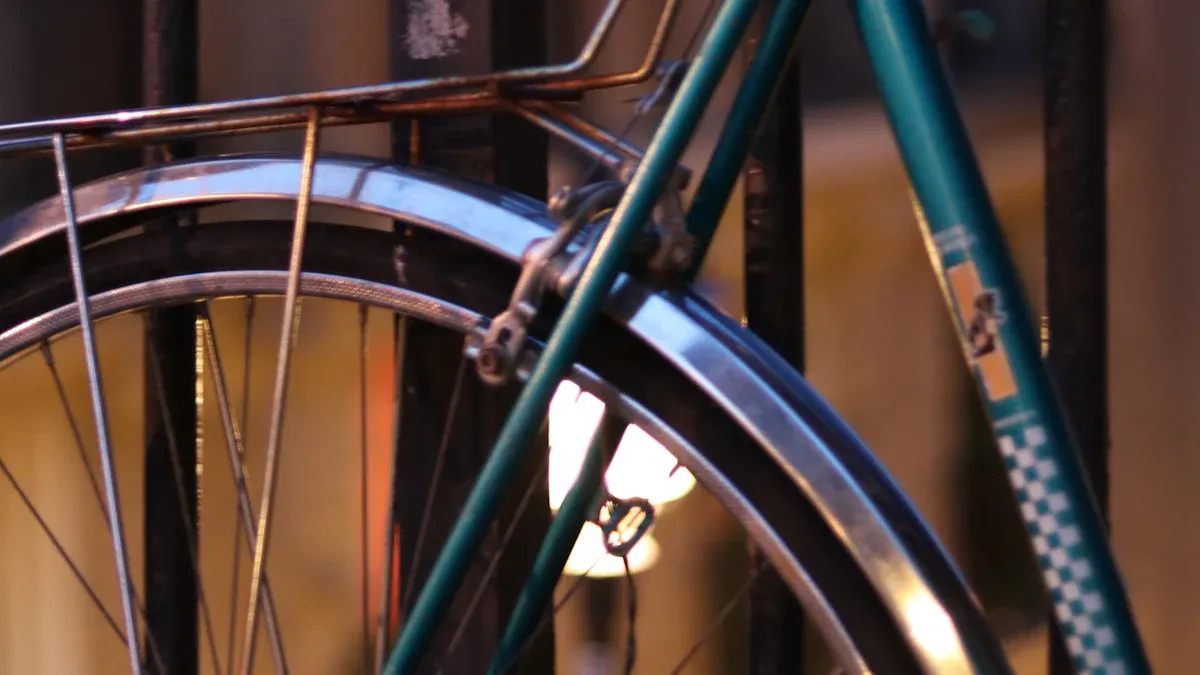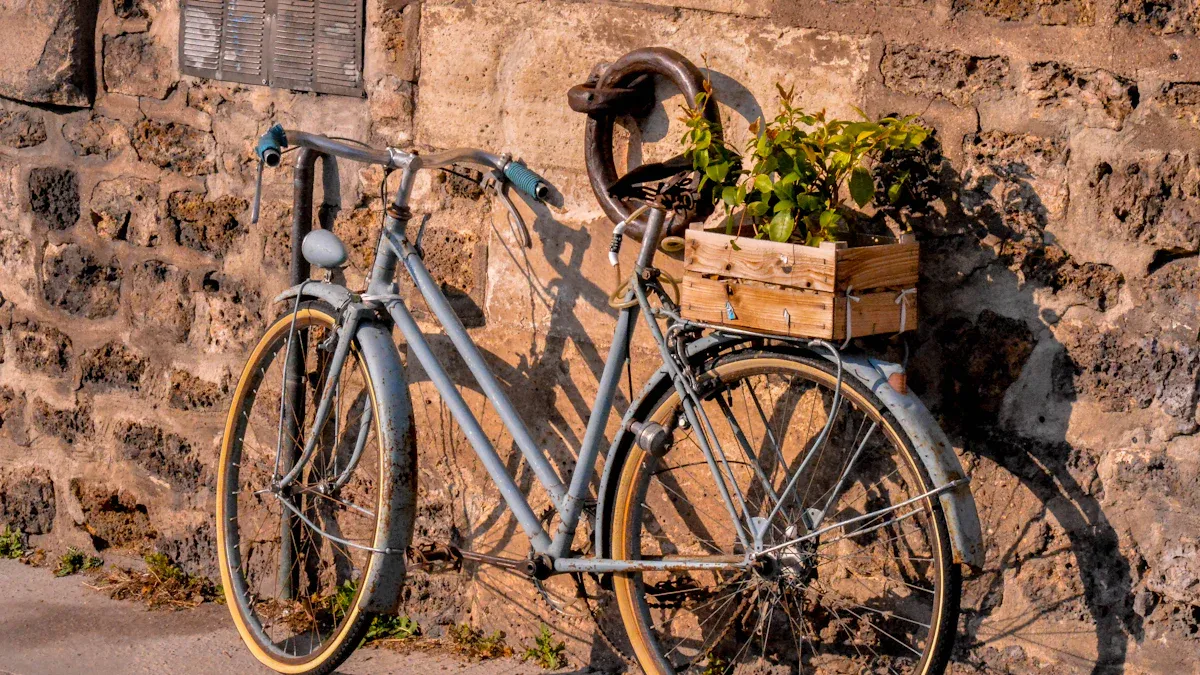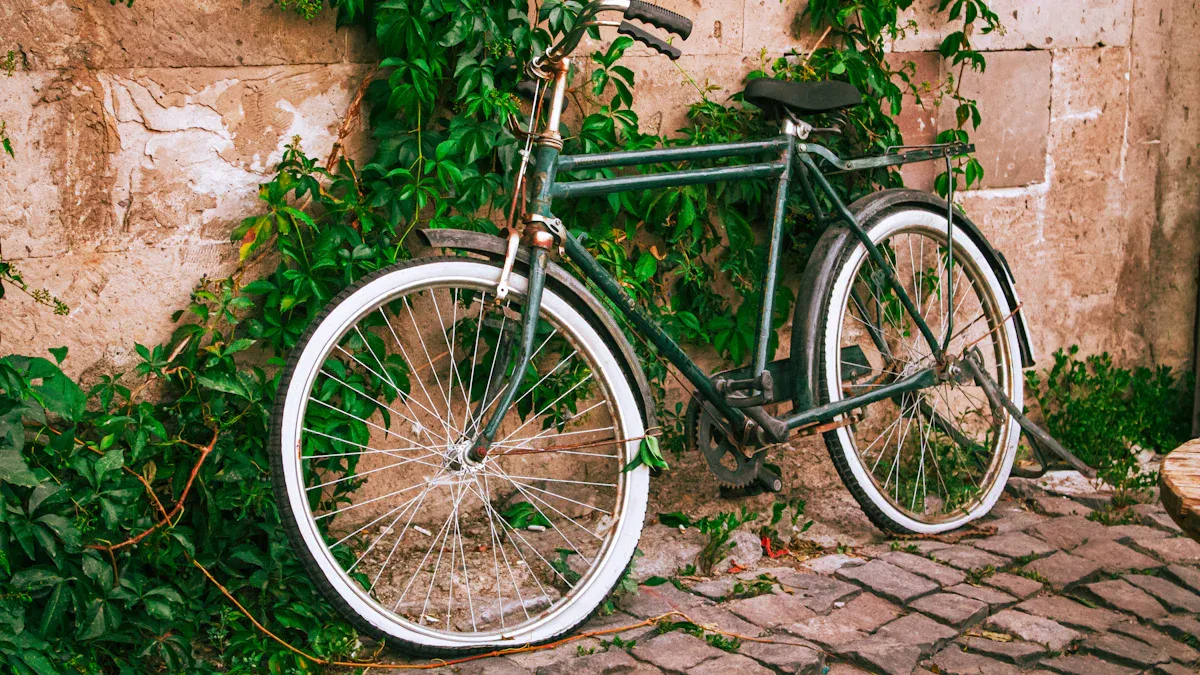
Nickel plating is very important for bicycle frames. You might not know this, but it has big benefits. It makes bikes last longer and look better. The shiny finish on a nickel bike frame looks great. It also helps protect against rust and scratches. As you learn about nickel plating, you will see how it affects old and new bicycles.
Key Takeaways
Nickel plating makes bicycle frames better. It helps prevent rust and gives a shiny look. This makes bikes last longer and look nicer.
Nickel plating started in the late 1800s. It was first used to make bike frames stronger and prettier.
Even though nickel plating was popular, the bike industry changed to chrome plating in the late 1920s. Chrome plating is stronger and resists rust better.
To keep nickel-plated frames looking good, clean them regularly with mild soap. This helps keep their look and strength.
Nickel plating is very important for fixing old bikes. It keeps the bike’s history safe and protects it from rust.
History of Nickel Plating

Early Adoption
Nickel plating started in bicycles in the late 1800s. Early users saw how it could make bikes stronger and nicer looking. There are old records showing when nickel plating was first used on bike frames. For example, many bike models from the early 1900s had nickel-plated handlebars and stems. These parts looked good and helped protect against rust and damage.
Description of Evidence | Details |
|---|---|
Nickel-plated handlebar and stem | Found in many bike models from the early 1900s |
Shiny nickel plating on handlebars and hubs | Seen in museum bikes before 1944 |
The Ladies Columbia Bicycle from 1896 is a famous example of early nickel-plated frames. This bike had a nicely designed nickel-plated steel frame with pretty floral designs. The Pierce Cycle Co. Fixed Gear Safety Bicycle from 1898 also had nickel-plated parts, showing the skill of that time.
Transition to Chrome
By the late 1920s, the bike industry began to change from nickel plating to chrome plating. This change happened for a few reasons. Buyers wanted a nicer look, and chrome plating gave a shiny, smooth finish that people liked. Also, chrome plating was stronger and resisted rust better than nickel.
The benefits of chrome plating showed how it improved bike frames. Here are some key benefits of chrome over nickel:
Chrome has a shiny look that makes bike frames more attractive.
It is strong, making it a better choice than nickel for lasting use.
Chrome plating helps resist rust and wear, adding to the strength of bike frames.
The electroplating process gives a shiny finish, making frames look better than nickel plating.
Chrome plating sticks better and is even, which helps frames with tricky shapes.
As you learn about nickel plating’s history, you can see how it helped shape bike building. While nickel plating was important in the early days of bike making, switching to chrome was a big step forward in design and function.
Advantages of Nickel Bike Frame

Corrosion Resistance
A nickel bike frame has great corrosion resistance. Nickel plating works like a shield against moisture and other elements. This helps stop rust, which is a big problem for bike frames in rain or humidity.
Tip: Clean your nickel bike frame often to keep it safe. Use a soft cloth and mild soap to wipe off dirt. This easy step can help your frame last longer.
Nickel plating also helps prevent scratches. The strong surface can handle small bumps, keeping your bike looking fresh. This strength makes nickel-plated frames a smart choice for everyday riders and fans.
Aesthetic Appeal
The aesthetic appeal of a nickel bike frame is very important. The shiny finish gives a classic look that many cyclists love. A well-kept nickel frame can attract attention and start chats at bike shows or group rides.
Main Characteristics | Application Areas | |
|---|---|---|
Nickel | Strong corrosion resistance, high brightness | Base plating, used to improve adhesion and resist corrosion |
Chromium | High hardness, excellent wear resistance, smooth surface | Surface plating, used to boost wear resistance and looks |
Nickel plating is the base for chrome plating, making the frame look better and last longer. While chrome shines brightly, the nickel layer underneath keeps the frame safe from rust. This mix of beauty and strength makes nickel bike frames popular with vintage bike restorers and collectors.
But, you should think about the cost of nickel plating. It usually costs more than chrome powder coating, but it is worth it for durability and looks. For example, Cycle Art charges over $800 for chrome plating a frame, showing how valuable quality finishes can be.
Nickel Plating Process
Technical Aspects
The nickel plating process has several important steps. These steps help make sure bicycle frames have a great finish. Here’s a simple list of the main steps:
Take off the old plating using sandblasting or by hand.
Get the NiCo solution ready by mixing certain chemicals in distilled water:
30 g of nickel chloride (NiCl2)
90 g of cobalt sulphate (CoSO4)
25 g of boric acid
9 ml of nickel carrier
0.2 ml of brightener.
Connect the nickel source to the positive side of a battery. Connect the object to be plated to the negative side.
Put the object in the solution and turn it every 30 seconds for even coating.
Rinse the plated item in distilled water and shake it to remove chemicals.
After plating, rinse the item well to get rid of all chemicals. Dry the item with a clean, soft cloth to avoid water spots.
The quality of nickel plating depends on some important factors. Here’s a summary of the key points:
Parameter | Specification/Details |
|---|---|
Usually 2-8 ASD | |
Tank Capacity | Small units start at 5L, big systems can be over 500L |
Deposit Thickness Consistency | ±10% tolerance |
Compliance Standards | ISO 4527 (electroless nickel), ASTM B689 (electrodeposited nickel) |
Deposition Rate | At least 12μm/hour for commercial systems |
Power Efficiency | kWh/kg of nickel deposited |
Bath Stability | Keep pH within ±0.2 |
After-sales Support | MTTR guarantees, technician available on-site |
Quality Control
Quality control is very important for nickel-plated bicycle frames. Different methods help keep high standards during plating. Here are some common quality control methods:
Quality Control Measure | Description |
|---|---|
Check the surface for evenness and no defects using 10X magnification. | |
Adhesion Testing | Tests to make sure the plating does not peel off, including tape tests and destructive methods. |
Thickness Testing | Non-destructive measurement of plating thickness using XRF equipment. |
Porosity Testing | Tests to find pores in the plating that could cause rust. |
Salt Spray Testing | Fast corrosion resistance test using misty salt water. |
Controlling hydrogen during the plating process is very important. Hydrogen embrittlement can make the metal weak, causing failures. One expert said, “I think the comment about chrome bike failures was more about stories related to bad post-plating baking than to chrome-plated frames in general.” This shows how important it is to follow proper steps to keep your nickel-plated bicycle frame safe and lasting.
By learning about the technical parts and quality control of the nickel plating process, you can see the skill behind your bicycle frame. This knowledge also helps you take care of your bike, making sure it stays a loved part of your collection for many years.
Vintage Bicycle Restoration and Nickel Plating
Restoration Relevance
Nickel plating is very important for fixing up vintage bicycles. Many experts want to keep the original look of these bikes. They focus on keeping the history and wear that comes with age. An old bike with some wear tells a story that shiny new ones can’t. Experts often prefer a bike that shows use over one that looks brand new.
Still, nickel plating has many benefits for restoration projects. It helps stop rust and gives a strong, nice finish. This process makes the bike look better and keeps it working well for a long time. For collectors and fans, a nicely restored nickel-plated bike can be very special.
Modern Techniques
Restoration experts use different methods to check and fix the original nickel plating on vintage bike frames. Here’s a simple list of the steps they take:
Removing old plating: The frame is soaked in a weak mix of water and muriatic acid to get rid of old chrome.
Polishing: This can mean filling in rough spots and plating with copper or nickel, then buffing to make it smooth.
Final coating: After polishing, the electroplating adds a thin layer of copper, then nickel, and chrome for a shiny look.
Nickel plating is not too expensive, but most costs come from getting the frame ready, not the plating itself. Other options like powder coating can be cheaper, with some costing about $100 for blasting and coating.
By learning about these modern methods, you can see the skill involved in restoring vintage bicycles. Taking good care of your nickel-plated bike will help it stay a loved part of your collection for many years.
Nickel plating has a big history in bicycle frames. It gives a nice, warm, smoky-gold color that many bike riders love. Nickel plating is strong, but it can get dull over time, so you need to take care of it.
To keep your nickel-plated bike looking great, clean it often with a soft cloth and mild soap. New studies show that some nickel plating methods can really improve how well it resists rust, helping your bike last longer.
Keep in mind, the nickel plating process is complicated. So, you should pick skilled platers for fixing up your bike. By knowing these things, you can see how valuable your nickel-plated bicycle is and keep it in great shape for many years.
FAQ
What is nickel plating?
Nickel plating is when a thin layer of nickel is put on a bicycle frame. This layer helps stop rust and gives the bike a shiny look. It makes the bike more attractive and strong.
How do I maintain my nickel-plated bike frame?
To take care of your nickel-plated bike frame, clean it often with a soft cloth and mild soap. Don’t use rough cleaners that can scratch it. This easy care keeps your bike looking nice and stops rust.
Can I restore a damaged nickel-plated frame?
Yes, you can fix a damaged nickel-plated frame. Experts can take off the old plating, polish it, and put on new nickel plating. This process makes the bike look good again and protects it from more damage.
Is nickel plating more expensive than other finishes?
Nickel plating usually costs more than powder coating. But, its strength and good looks make it a smart choice for vintage bike lovers and collectors.
Why is nickel plating important for vintage bicycles?
Nickel plating is very important for vintage bicycles because it helps keep their historical value. It makes them look better and protects against rust, which makes these bikes more interesting to collectors and fans.
See Also
Transitioning From Iron to Carbon in Bike Frame Design
Discovering the Innovations in Carbon Fiber Bicycle Frames
Understanding Why Chromoly Frames Are Beneficial for Bicycles
